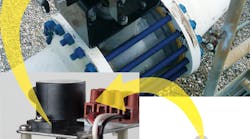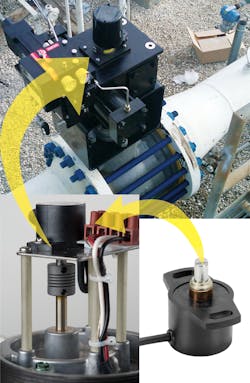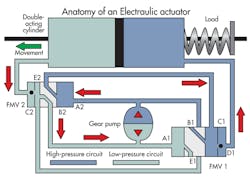|
Resources Novotechnik U. S., www.novotechnik.com |
The rotary-sensor signal provides feedback to a controller which handles the electrohydraulic actuator. The actuator must respond within as little as a few hundred milliseconds to move ball valves spanning 12, 16, 20 in. or more.
The Electraulic actuator from Koso America, West Bridgewater, Mass., consists of two major components, the actuator itself (hydraulic cylinder, feedback circuit, and power module) and a control enclosure. The actuator sits on the pipeline valve, while the enclosure mounts some distance away. The Electraulic Power Module delivers oil to a hydraulic cylinder and includes a positioning electric motor, gear pump, valves, a hydraulic oil reservoir, heater, and thermostat.
The controller converts an incoming command into a target position. It uses the rotary angle sensor, an RSC 2800 model made by Novotechnik U. S., Southborough, Mass., to determine the real position. The difference between the target and real position is the error. Error above a certain level starts the electric motor to make a correction. Thus, the actuator only draws energy when a valve needs repositioning.
The sensor uses the orientation of a magnetic field from a magnet to determine the measurement angle. The magnet attaches to the sensor shaft, while an integrated circuit notes the magnetic field orientation. A 4-to-20-mA analog output signal represents the calculated angle. Pump vibrations don’t bother the noncontact sensor which gives a position resolution of 0.04% and a repeatable angle measurement within ±0.20°.
The electric motor drives a reversible hydraulic pump which can pressurize either side of a double-acting cylinder through what are called Flow Matching Valves. Each of these valves has a ported spool with a pilot-operated check valve.
The actuators help control pipeline back pressure to ensure there is no cavitation as oil flows. Cavitation arises when the static pressure of the liquid falls below its vapor pressure. In the presence of cavitation, bubbles will collapse as they pass into regions of higher static pressure upstream towards the pump. This causes noise and vibration, which may damage the pump and diminish pumping capacity.


